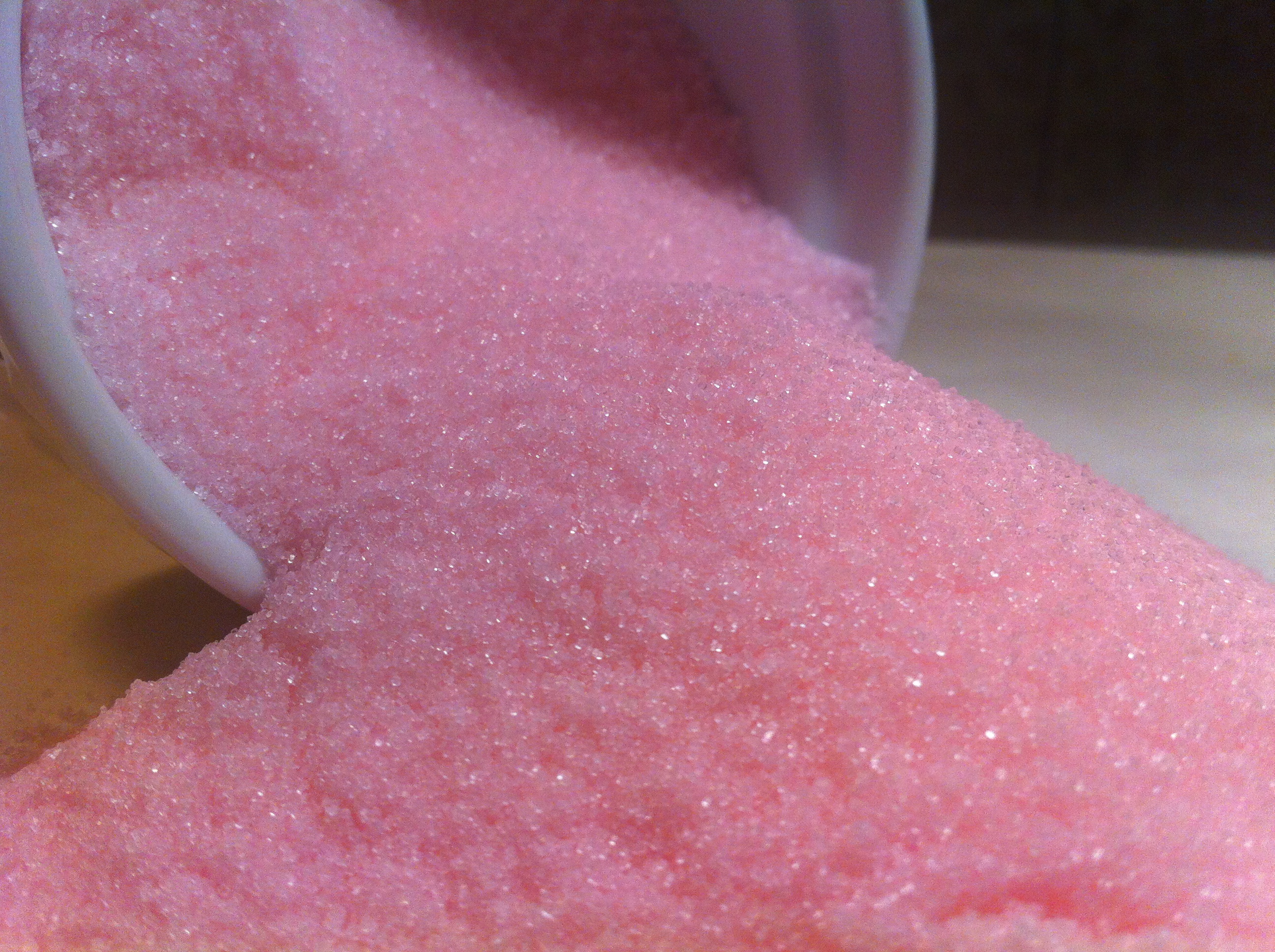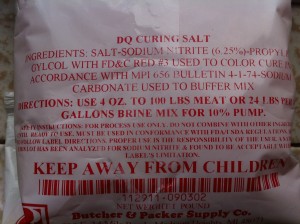
Nitrates and Nitrites
 Sodium Nitrates and Nitrites are used in the curing and preserving of meat. Most commonly you’ll find them in bacon, sausages, and hot dogs. It has long been known that salt acts a preservative for meat, killing off certain bacteria as it reduces moisture in meat, thus making it harder for bacteria to grow. A natural form of sodium nitrate, saltpeter, was used (it is still used used today, but not as often) to preserve meat as early as Homer’s time (850 B.C.). The Romans first noted one of the effects of nitrates- that it kept the meat an appealing pink color as opposed to turning gray. As with all discoveries, it was purely coincidental that the saltpeter had this affect on meat, and it wasn’t until the 20th century that we fully understood the role that nitrates and nitrites played in preserving meat, how to utilize them, and, eventually, how to blame them for cancer.
Sodium Nitrates and Nitrites are used in the curing and preserving of meat. Most commonly you’ll find them in bacon, sausages, and hot dogs. It has long been known that salt acts a preservative for meat, killing off certain bacteria as it reduces moisture in meat, thus making it harder for bacteria to grow. A natural form of sodium nitrate, saltpeter, was used (it is still used used today, but not as often) to preserve meat as early as Homer’s time (850 B.C.). The Romans first noted one of the effects of nitrates- that it kept the meat an appealing pink color as opposed to turning gray. As with all discoveries, it was purely coincidental that the saltpeter had this affect on meat, and it wasn’t until the 20th century that we fully understood the role that nitrates and nitrites played in preserving meat, how to utilize them, and, eventually, how to blame them for cancer.
When sodium nitrate is used as a curing agent for meat, it turns into sodium nitrite. Did you catch that? Sodium nitrate turns into sodium nitrite, and it is the sodium nitrite that is most beneficial in preserving meat. The use of sodium nitrites in curing serves three functions:
- Nitrites kill a large amount of bacteria, but, most importantly, it kills the bacteria responsible for botulism.
- Nitrites help preserve the appealing pink color we associate with meat and keeps the fat from developing rancid flavors
- The use of nitrites helps the meat to develop a more pleasing flavor.
If you plan on doing a long cure with your meat (several weeks or longer) you can use sodium nitrates, as they will slowly turn into sodium nitrites, but for quicker cures, a form of sodium nitrite is now chemically produced. The form of curing salt containing sodium nitrite is always the same formula: 93.75% salt and 6.25% sodium nitrite. This goes by several names: DQ Curing Salt, InstaCure #1, and most commonly, pink salt. The salt is dyed pink so it is not to be confused with any other type of salt. Nitrites naturally occur in many green leafy vegetables and root vegetables, and when we eat foods containing natural sodium nitrates, they are converted to sodium nitrite during the digestive process. The majority of our ingestion of nitrates and nitrites comes from fruits and vegetables.
Nitrates and Nitrites have been the center of debate for several years now, with some claiming they are linked to certain cancers. After more studies it’s been discovered that what is actually linked to cancer is something called ‘nitrosamines.’ When a product containing nitrites and high protein levels is heated to high temperatures it can form a carcinogenic compound known as nitrosamines. Researchers at the USDA Agricultural Research Center (ARC) found that by adding vitamin C (aka ascorbate) and vitamin E (aka tocopherol) the levels of nitrosamines were reduced in fried bacon. Because of this it is now a federal regulation that sodium ascorbate or sodium erythorbate be added to certain products to minimize the presence of nitrosamines. Several studies have shown that nitrosamines are rarely found in cured meats, except overcooked bacon. Bacon products are routinely cooked and sampled to test for levels of nitrosamines before being sold to the public. This is from the USDA Food Safety and Inspection Service:
“A bacon cooking study, “Effect of Frying and Other Cooking Conditions on Nitrosopyrrolidine Formation in Bacon” (Journal of Science, Vol. 39, pages 314-316), showed no evidence of nitrosamines in bacon fried at 210 °F for 10 minutes (raw), 210 °F for 15 minutes (medium well), 275 °F for 10 minutes (very light), or 275 °F for 30 minutes (medium well). But when bacon was fried at 350 °F for 6 minutes (medium well), 400 °F for 4 minutes (medium well), or 400 °F for 10 minutes (burned), some nitrosamines were found. Thus, well-done or burned bacon is potentially more hazardous than less well-done bacon. Also, bacon cooked by a microwave has less nitrosamine than fried bacon.”
Even though the National Academy of Sciences, The American Cancer Society, and the National Research Council have all concluded that there is no risk of cancer from consuming nitrites, many people are still wary. As a result of all the false claims that nitrates and nitrites cause cancer, there are currently products offered that are marketed as “no added nitrates or nitrites.” Since completely uncured products don’t taste good, they use celery juice or celery powder in place of the sodium nitrites. Why, because celery is naturally high in sodium nitrate which turns into, guess what- sodium nitrite. These products can then claim to be ‘natural’ but in most cases these ‘natural’ products contain way more sodium (sometimes up to ten times more) than conventional products. I have tried many varieties of ‘no added nitrates or nitrites’ products and I have no complaints about the taste, but I don’t buy the marketing gimmick of ‘natural.’
For many of our charcuterie adventures at Steaks and Chops, we will be using pink salt. The amount of pink salt used in a cure is minimal (the ratio is four ounces to every one hundred pounds of meat), and the risk of botulism is not one I’m willing to take. Pink salt is available online (not to be confused Himalayan pink salt) and at specialty meat shops. Bottom line- Sodium Nitrates and Nitrites have not been proven to be harmful in small amounts (but can be toxic in large amounts- don’t eat it by the spoonful). The only thing proven to be harmful are nitrosamines which are present mostly in overcooked bacon, and vitamin C and E can counteract some of the negative effects. So don’t burn your bacon and eat a couple of oranges if you’re still worried.
Still don’t believe a word I’ve said, no hard feelings. Check out what the experts have to say:
http://www.extension.umn.edu/distribution/nutrition/DJ0974.html
http://www.meatscience.org/page.aspx?id=403
http://www.fsis.usda.gov/Factsheets/Bacon_and_Food_Safety/index.asp#11
http://www.ajcn.org/content/90/1/11.full.pdf+html
2 thoughts on “Nitrates and Nitrites”
Comments are closed.